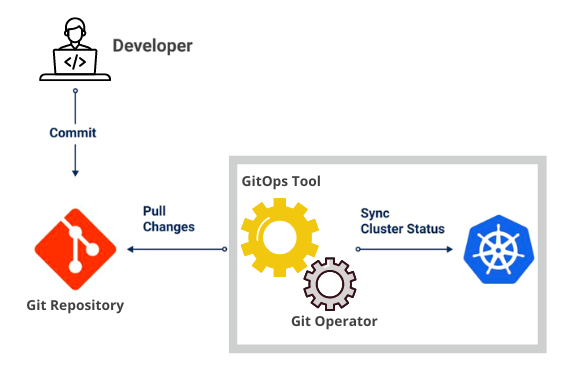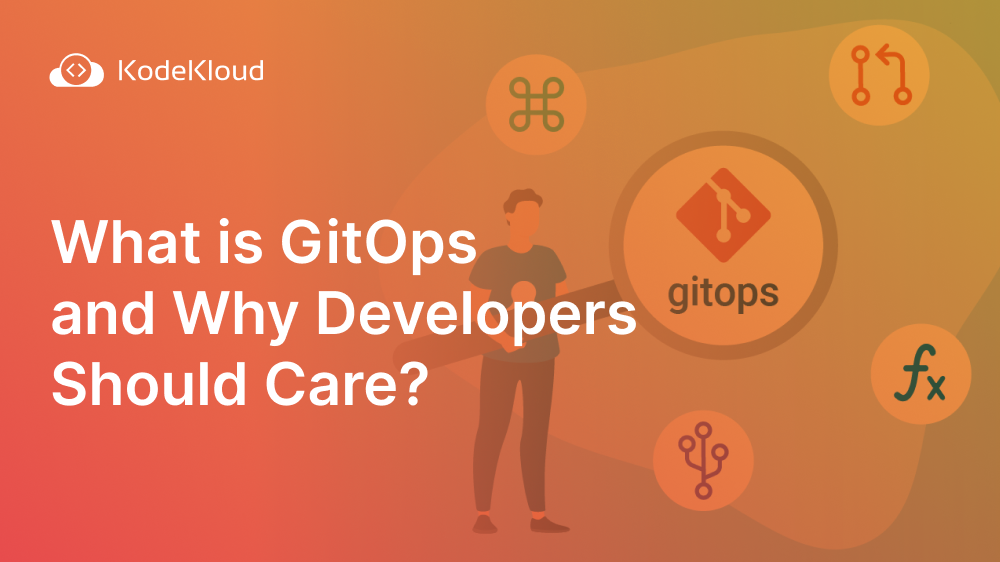GitOps is a methodology for deploying and managing software applications using Git. It is also referred to as "operations as code" or "code-driven operations," and it uses the principles of DevOps to streamline software updates across an organization. It basically uses a collaborative software development model involving Git and Kubernetes.
You can also define GitOps as the combination of Git and Ops, a practice where you use the principles of operations to manage your version control system. When we talk about version control, it’s mostly about code in a repository. GitOps takes this one step further by applying principles of operations to your version control system.
How Does GitOps Work?
GitOps is the union of two disciplines: Operations, which is responsible for managing your infrastructure, and Git, the version control system developers use to manage their code. GitOps brings these two disciplines together, making the code and infrastructure development process more accessible and coordinated for everyone involved.
GitOps makes it easier for engineers to work with infrastructure and deploy code. This makes workflows faster, more accessible, and more coordinated for everyone involved.
GitOps has the following main goals:
- Accelerate the development process by making infrastructure operations part of the code itself.
- Automate and standardize operations across the entire application lifecycle.
- Enable engineers to work with systems that are easier to access and use than a traditional operations model.
- Improve collaboration between development and operations teams by using simple workflows.
How Does GitOps Work?
Why use the principles of operations to manage version control? Because it makes more sense to manage your code the same way you manage your infrastructure. This makes the code and infrastructure development process more accessible and coordinated for everyone involved.

Keeping your application code in a Git repository and syncing the state of the Kubernetes cluster with it (application code, files, dependencies, manifests, etc.) is the central idea behind GitOps. Typically, developers push new code to a Git repository, and an agent keeps track of the manifest file changes. The agent sees what has changed and syncs it to match the desired/expected state.
GitOps is available in two models—push and pull. In the push-based model, your CI/CD tool pushes changes to your production environment. In the pull-based model, an agent must be installed on every cluster. It tracks changes and pulls them in whenever there is a discrepancy from the required configuration. Argo CD, FluxCD, and JenkinsX are three big tools that pioneered GitOps.
There are a few ways you could implement GitOps in your organization. One way is to use tools like ArgoCD or FluxCD. Otherwise, you can also use your organisation's existing CI/CD tools to deploy with Kubernetes. GitOps works by setting up a workflow that allows the code in your repository to trigger specific actions.
- Set up CI/CD
- Create a pipeline that is triggered by a push to the code repository.
- Decide what actions you want to take when the pipeline is triggered.
- Decide what artifacts you want to deploy.
- Decide on the target environment. It is assumed that Kubernetes-related deployments work well with GitOps, but you can also use any target environment other than Kubernetes.
- Decide how to trigger the actions.
What Is the Difference Between GitOps and Traditional Ops?
GitOps and traditional operations often work hand in hand at many organizations. Although they are not exactly the same, they share the same goal of enabling efficient and automated software delivery. The main difference between GitOps and traditional operations is that the latter is often tightly coupled with the deployment software (Ansible, Puppet, Terraform, etc.).
GitOps, however, doesn’t rely on any particular tool or service. It’s only focused on the data and doesn’t care about the underlying infrastructure. Because of this, it offers a lot of flexibility and can be applied in different environments.
Why Should You Care About GitOps?
GitOps is a software delivery methodology that combines the principles of DevOps and the collaborative nature of Git. GitOps is a natural progression from DevOps and CI/CD. When you’re in the early stages of implementing DevOps, you have a central repository where you store all your code.
This is where you have your code written, tested, and ready to be deployed. So, for most DevOps processes, the fundamental of CI/CD is the Git repository.
GitOps is an excellent way to create fast feedback loops, enable continuous deployment, and improve your software delivery. The traditional way of doing things is to have a separate team responsible for operations. This team is responsible for managing the underlying infrastructure, tools, etc., and then using that infrastructure to deploy software to the customers.
On the other hand, with GitOps, your software team pulls code off their repository and pushes their code directly to the deployment server. As a result, you get faster iteration cycles and a better feedback loop.
Elements of Successful GitOps Methodology
Although GitOps is a relatively new concept, its general idea has existed for a while. Here are the six elements of successful GitOps techniques:
Controlled Workflow
A controlled workflow is one of the cornerstones of any GitOps process. It typically includes a workflow system, such as Jira or Gitea, that tracks your code from inception to delivery. The controlled workflow tracks code commits, issues, and dependencies. When you have all of this information, it gets much easier to deliver new features and resolve any issues.
- Centralized Repository
Having a centralized repository is one of the requirements for a successful GitOps implementation. Since many developers are already familiar with version control systems like Git, BitBucket, GitLab, etc., it becomes easy for Dev and Ops to collaborate and work together. Onboarding new developers will also be easy as the learning curve will be negligible.
- Automated Testing
While many companies struggle with implementing automated testing, it’s a crucial part of any sustainable GitOps process. Automated testing is essential for continuous delivery and providing fast feedback. When you run automated tests, you can identify potential issues or regressions in your code before it’s deployed to customers.
- Clean Code Quality
Code quality is another vital part of any sustainable GitOps process. You want to ensure that your code is well-written, efficient, and easy to maintain. In order to ensure that your team is complying with your code quality standards, you can use continuous code quality tools. These tools help you integrate code quality metrics with your code review system.
- Automated Code Review
Automated code review is an excellent way to reduce the amount of work that your code review team needs to do. Automated code review tools run unit tests, static analysis, and a multitude of other tests to identify potential issues in your code. Automated code reviews make it easy for GitOps deployments.
- Collaboration
Last but not least, collaboration is one of the key principles of successful GitOps. GitHub is an excellent example of a collaboration platform that enables developers to work together efficiently. By making your collaborative workflow as efficient as possible, you can increase the rate at which your team can work together. Having a well-organized repository is important to see who’s working on what and when something is expected to be done.
Check out the following GitOps with ArgoCD course:

Conclusion
GitOps is a powerful methodology that can transform how developers work with software deployment. It brings together the principles of operations to version control, making it easier for engineers to work with infrastructure, deploy code, and collaborate between development and operations teams. GitOps is a robust methodology that can transform the way you work.
It brings the principles of operations to version control, making it easier for engineers to work with infrastructure, deploy code, and collaborate between development and operations teams.
People are also reading:




















Discussion